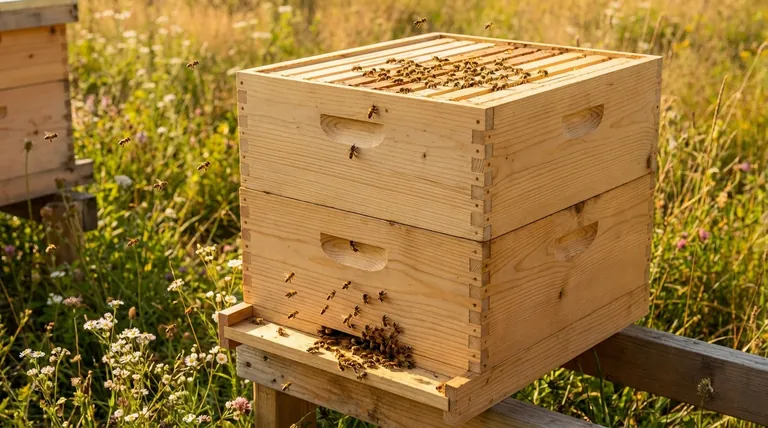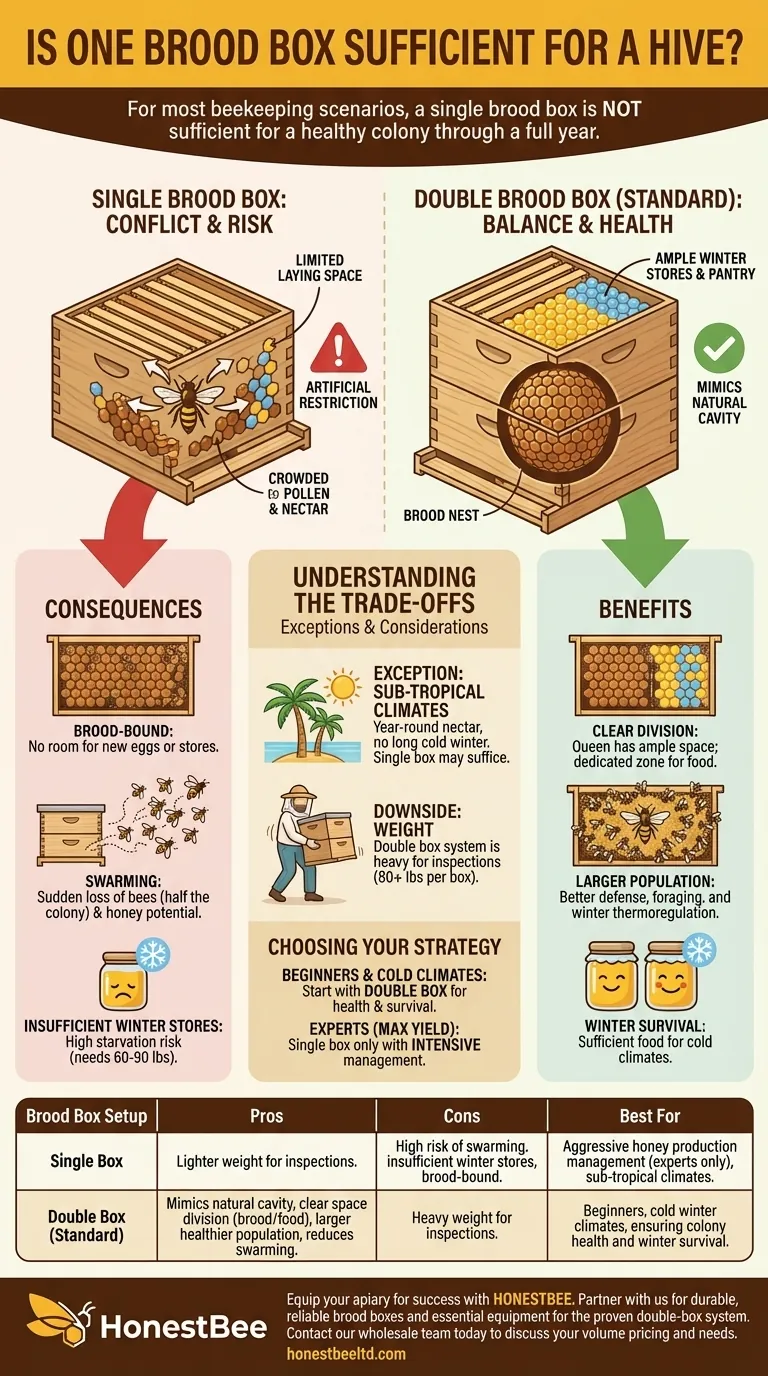In almost all beekeeping scenarios, a single brood box is not sufficient for a healthy, thriving honey bee colony through a full year. This limited space artificially restricts the queen's ability to lay and severely curtails the colony's capacity to store the food required for winter survival. Using a single box often forces the colony into a crisis, increasing the likelihood of swarming or starvation.
The decision on brood box configuration is not just about equipment; it's a fundamental choice that dictates your colony's potential. A single box creates an unnatural conflict between raising new bees and storing food, whereas a two-box system allows the colony to manage both essentials successfully.

Why a Single Brood Box Creates Conflict
A honey bee colony operates on a simple, powerful instinct: expand the population and store enough resources to survive the next winter. A single brood box directly obstructs both of these imperatives.
The Queen's Need for Space
The brood box is the heart of the hive, serving as the nursery where the queen lays eggs. A healthy queen can lay up to 2,000 eggs per day during peak season.
A standard 10-frame Langstroth box simply does not have enough cells to accommodate a prolific queen's laying pattern and the immediate pollen and nectar stores the nurse bees need. This quickly leads to the box becoming brood-bound, a state where there is no more room for the queen to lay.
The Colony's Drive to Swarm
When a colony senses it is running out of space, its primary survival mechanism is to swarm. This is the natural process of bee reproduction at the colony level.
The bees will raise a new queen, and the original queen will leave with roughly half the hive's population. For the beekeeper, this means a sudden and dramatic loss of bees, which cripples the hive's honey production potential for the season. A single brood box dramatically accelerates this swarming impulse.
The Critical Need for Winter Stores
A colony requires a significant amount of honey to generate heat and feed itself through a cold winter—often between 60 to 90 pounds, depending on the climate's severity and duration.
A single deep brood box does not provide nearly enough space to store this much honey in addition to the space needed for the brood nest. The bees are forced to choose between raising replacements and packing away food, a choice they are not equipped to make.
The Standard: A Double Brood Box System
For beekeepers in climates with cold winters, the two-box brood chamber is the established best practice for a reason. It provides a much more stable and forgiving environment for the colony.
Mimicking a Natural Cavity
Two deep boxes stacked on top of each other more closely mimic the vertical space a colony would naturally occupy in a hollow tree. This allows them to organize their home in an intuitive way.
A Clear Division of Space
In a double-box system, the colony typically establishes a large, sphere-shaped brood nest across the center of both boxes. However, the dominant pattern is for the bottom box to be primarily for brood and the top box to become the main pantry for winter honey.
This configuration gives the queen ample laying space while also providing a dedicated zone for long-term food storage, resolving the core conflict created by a single box.
Promoting a Larger, Healthier Population
More space allows the queen to lay to her full potential, creating a massive workforce. A larger population means more foragers, better defense against pests, and a greater ability to thermoregulate the hive through winter's cold.
Understanding the Trade-offs and Exceptions
While the double-box system is the standard, there are specific situations and management styles where a single brood box is used. It's crucial to understand the context.
The Exception: Sub-Tropical Climates
In regions with year-round nectar flows and no long, cold winter, the need for massive honey stores is greatly reduced. In these environments, a single brood box can be sufficient because the colony is not preparing for a months-long confinement.
The Exception: Aggressive Management
Some advanced beekeepers use a single brood box as a specific management technique to drive bees upward into honey supers more quickly. This strategy requires constant and expert-level monitoring to prevent the hive from becoming honey-bound or swarming. This is not a recommended strategy for new beekeepers.
The Downside of Two Boxes: Weight
The primary disadvantage of a double-brood-box system is weight. A single deep box full of honey, pollen, and brood can weigh over 80 pounds (36 kg). Lifting two of these for inspections is a significant physical challenge and a valid consideration for any beekeeper.
Choosing Your Brood Box Strategy
Your decision should be based on your climate, your goals, and your experience level.
- If your primary focus is colony health and winter survival (especially for beginners): Start with and plan for a two-brood-box system. It is the most forgiving and reliable method for establishing a strong, resilient colony.
- If you live in a climate with cold winters: A two-brood-box system is the definitive standard for ensuring your bees have enough space for both brood and food.
- If you are an experienced beekeeper focused on maximizing honey yield: You might experiment with single-box management, but only if you fully understand the intensive swarm-control measures required.
Providing your colony with adequate space is the foundation of responsible and successful beekeeping.
Summary Table:
| Brood Box Setup | Pros | Cons | Best For |
|---|---|---|---|
| Single Box | Lighter weight for inspections. | High risk of swarming, insufficient winter food storage, colony becomes brood-bound. | Aggressive honey production management (experts only), sub-tropical climates. |
| Double Box (Standard) | Mimics natural cavity, clear space division (brood/food), larger healthier population, reduces swarming. | Heavy weight for inspections. | Beginners, cold winter climates, ensuring colony health and winter survival. |
Equip your apiary for success with HONESTBEE.
Building a resilient, high-yield apiary starts with the right foundation. Our wholesale-focused operations supply commercial apiaries and beekeeping equipment distributors with the durable, reliable brood boxes and essential equipment needed to implement the proven double-box system.
Partner with HONESTBEE to ensure your colonies have the space they need to thrive, maximizing honey production and ensuring winter survival. Contact our wholesale team today to discuss your equipment needs and volume pricing.
Visual Guide

Related Products
- Langstroth Honey Bee Box Hive Boxes for Different Depths
- Australian Langstroth Beehive Boxes for Beekeeping Wholesales
- Portable Bee Mating Hive Boxes Mini Mating Nucs 8 Frames for Queen Rearing
- In-Hive Dual Compartment Frame Bee Feeder for Targeted Colony Nutrition
- Professional Insulated Plastic Bee Hives
People Also Ask
- Why do you need two bee hives? Boost Your Apiary's Success with Smart Risk Management
- What are the sizes available for Langstroth boxes? A Guide to 8-Frame vs. 10-Frame & Depths
- How deep is a medium bee box? Unlock the Key to a Versatile and Manageable Hive
- How does a hive box work? A Guide to the Langstroth Hive System for Beekeepers
- What factors should beekeepers consider when choosing between wooden and polystyrene hives? Maximize Bee Health and Honey Production



















